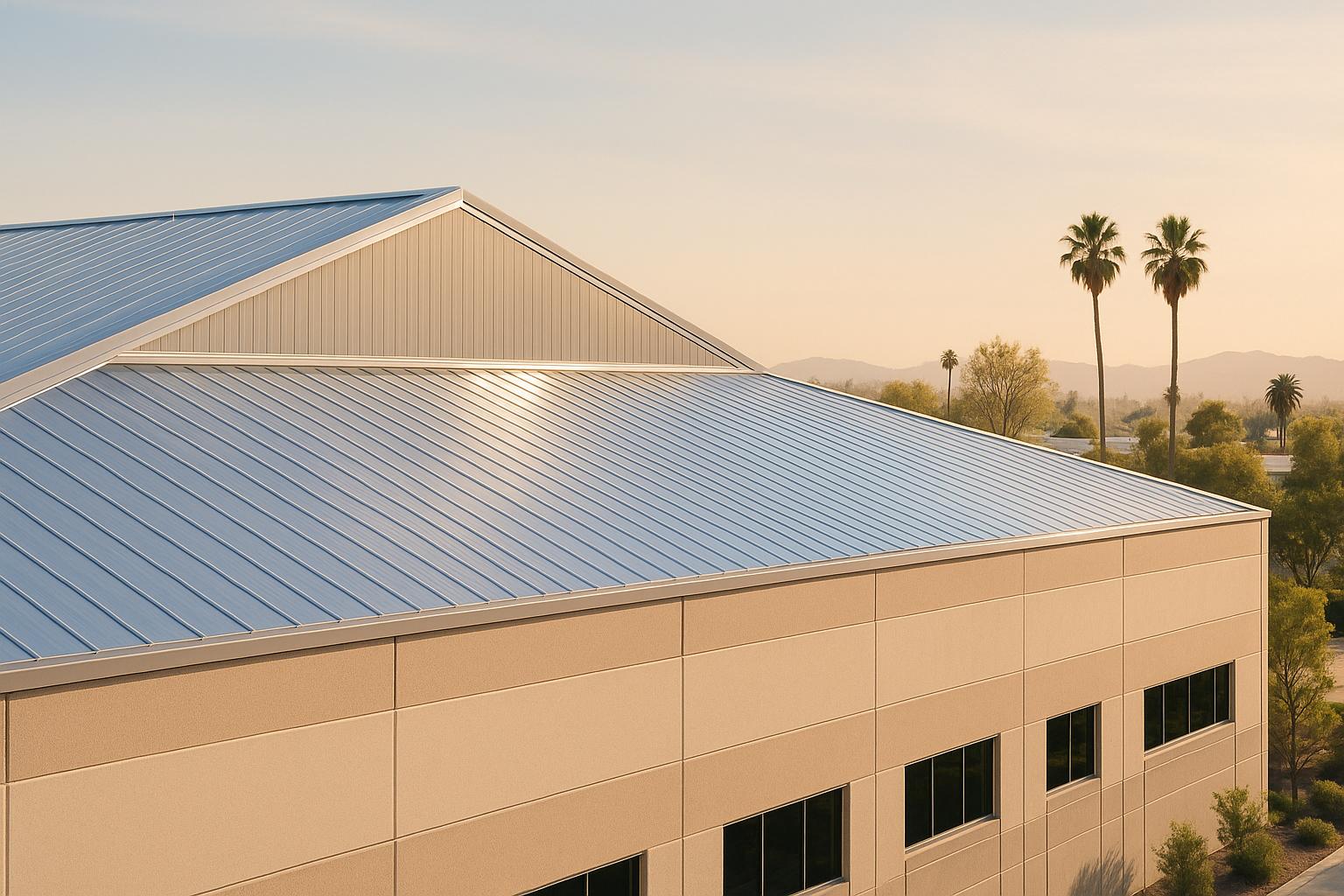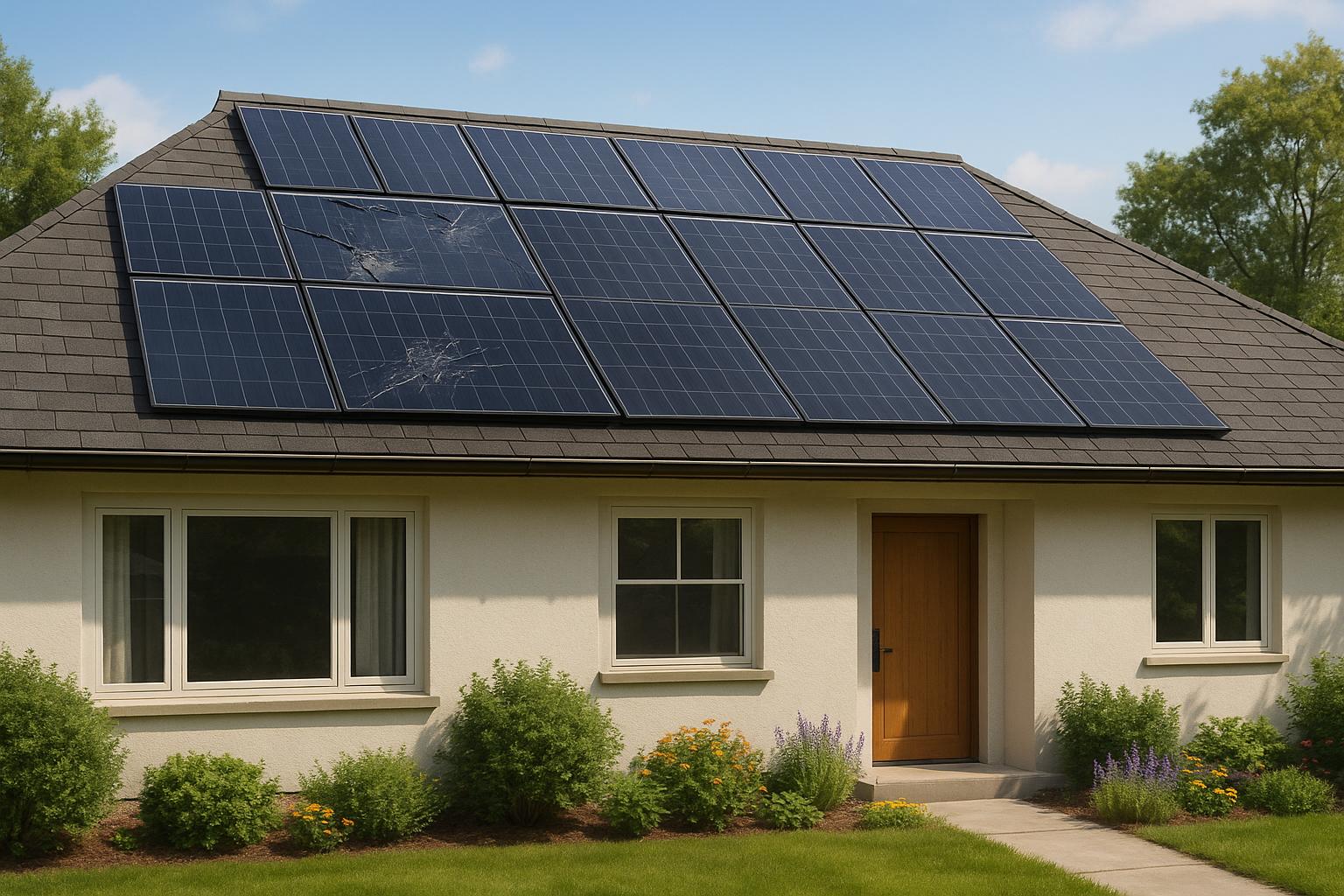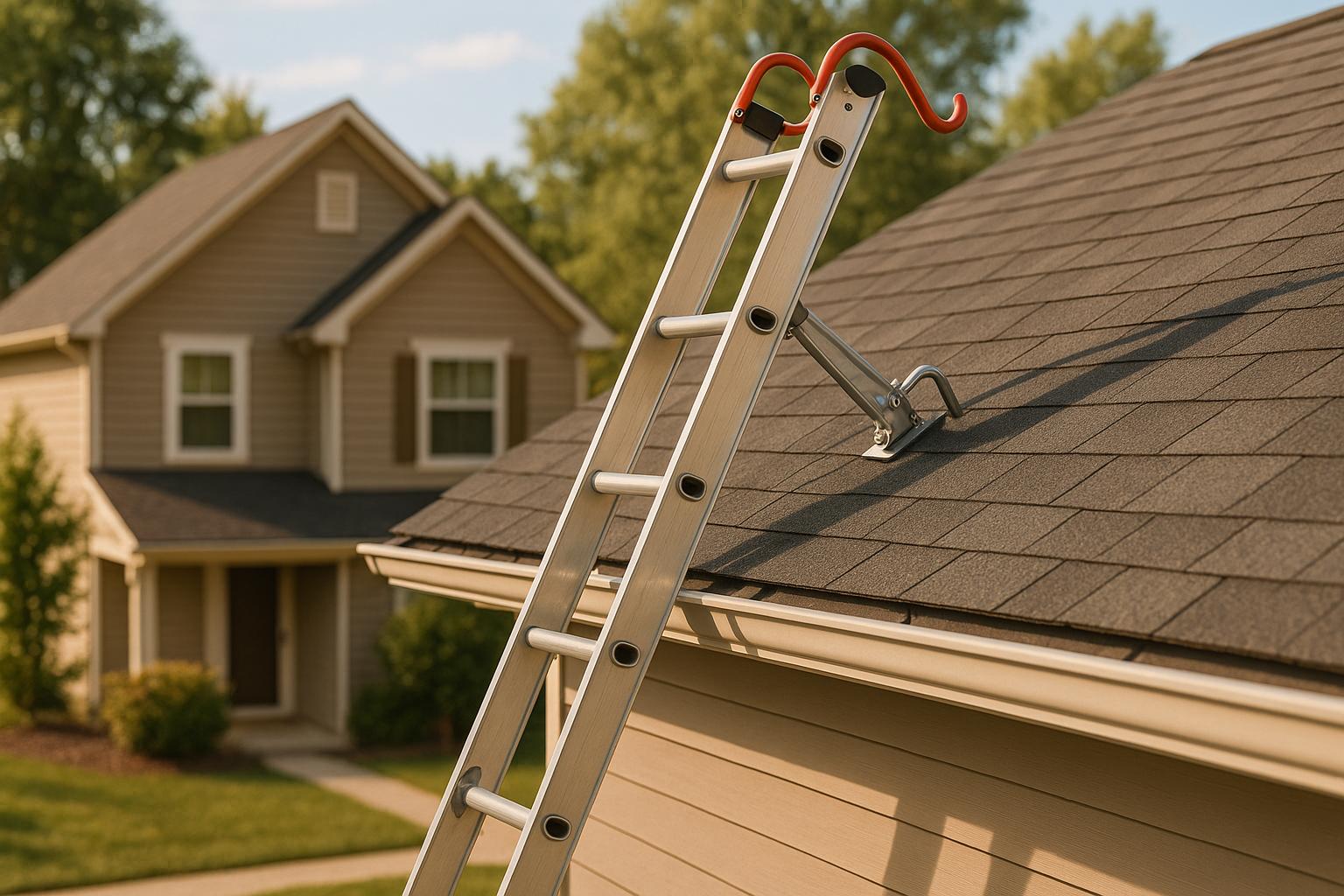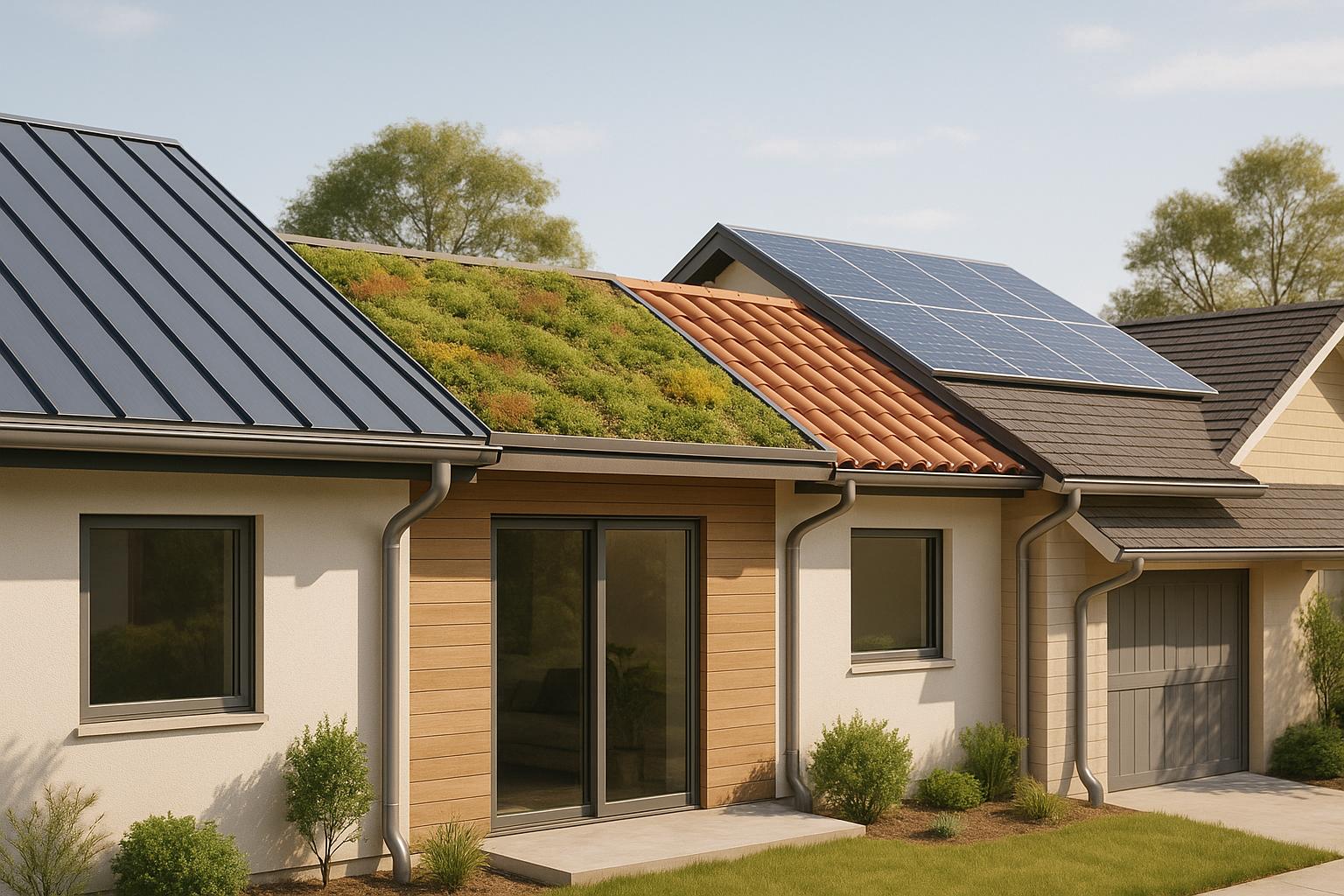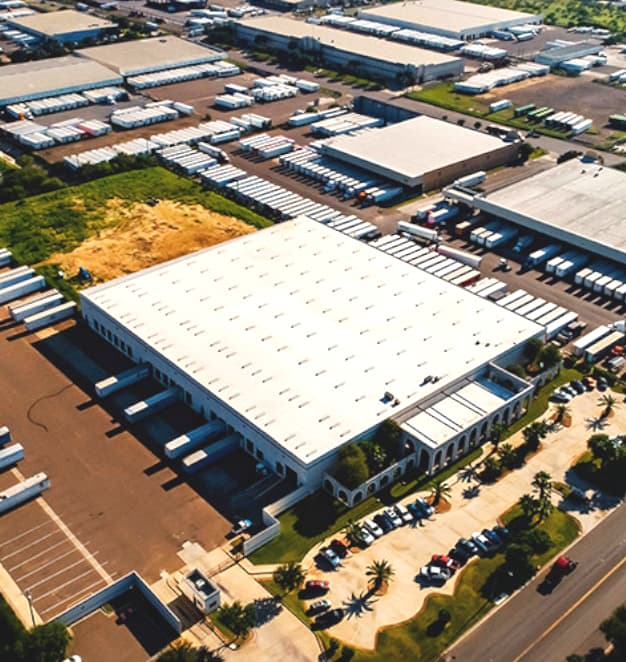Selecting the right roofing for your Los Angeles warehouse can save you money, improve energy efficiency, and protect your property. Here’s a quick guide to the five most common options:
- Metal Roofing: Durable (40–70 years), energy-efficient (up to 25% cooling savings), but higher upfront costs ($7.24–$15.20/sq. ft.).
- Single-Ply Membranes: Affordable ($3–$10/sq. ft.), reflective, and quick to install, but less durable than metal.
- Modified Bitumen: Multi-layered for strength, moderate cost ($850–$1,000 per square), but requires regular maintenance.
- Built-Up Roofing (BUR): Long-lasting (20–30 years), good for waterproofing, but labor-intensive and costly ($5.50–$10/sq. ft.).
- Spray Polyurethane Foam (SPF): Seamless, energy-efficient, and long-lasting (40–50 years), but specialized installation costs $5–$10/sq. ft.
Quick Comparison
| Roofing System | Lifespan | Energy Efficiency | Installation Cost (per sq. ft.) | Maintenance Level |
|---|---|---|---|---|
| Metal | 40–70 years | Excellent | $7.24–$15.20 | Low |
| Single-Ply Membranes | 15–40 years | Good | $3–$10 | Low |
| Modified Bitumen | 20–30 years | Moderate | $850–$1,000 per square | Moderate |
| Built-Up Roofing | 20–30 years | Moderate (with coating) | $5.50–$10 | High |
| SPF | 40–50 years | Excellent | $5–$10 | Low |
For energy savings, choose metal or SPF. For affordability, single-ply membranes work well. Always ensure compliance with California’s Title 24 standards for cool roofing materials.
Everything You Need To Know About Warehouse Roofing
1. Metal Roofing Systems
Metal roofing stands out as a reliable option for warehouses in Los Angeles, offering exceptional longevity and resilience.
Durability
When it comes to durability, metal roofing systems are hard to beat for warehouse applications. Steel roofs are built to withstand harsh conditions like hail, strong winds, and debris impacts. They can last anywhere from 40 to 70 years – far surpassing the lifespan of traditional asphalt shingles. Plus, they resist common issues like cracking, warping, and rotting, which means less downtime for repairs or replacements. Beyond their toughness, these roofs also contribute to lower energy costs.
Energy Efficiency
Los Angeles’s sunny climate makes energy efficiency a key consideration, and metal roofs deliver in spades. Thanks to their reflective properties, metal roofs can lower surface temperatures by around 10°C on sunny days. This helps keep interior spaces cooler and reduces the strain on HVAC systems. The result? Cooling energy savings that range from 15% to 30%, with some cases reporting up to a 25% drop in cooling costs. When combined with proper insulation, metal roofs enhance energy performance throughout the year.
Installation Complexity
While the energy savings are impressive, installation is another factor to consider. Metal roofing installation requires skilled contractors, but the process is generally straightforward. The complexity largely depends on the type of system chosen. For instance, exposed fastener panels are more affordable but less sophisticated, costing about half as much as concealed fastener (standing seam) systems. Standing seam roofs, though pricier and more intricate to install, provide better weather protection and a sleeker appearance.
Cost
Although metal roofing comes with higher upfront costs, it offers excellent long-term value. In Los Angeles, installation costs range from $7.24 to $15.20 per square foot, with material type playing a significant role in pricing. Here’s a breakdown:
| Material Type | Cost per Square Foot |
|---|---|
| Steel (Galvalume/Galvanized) | $1.50 – $3.50 |
| Steel (Painted) | $2.00 – $4.00 |
| Aluminum | $3.50 – $6.50 |
| Corrugated Metal | $1.50 – $4.00 |
| Standing Seam | $2.20 – $8.25 |
Over time, metal roofs can deliver a return on investment (ROI) of 60% to 85%. Maintenance costs are relatively low, typically ranging from $0.15 to $0.30 per square foot annually. Repairs, when needed, usually cost between $5 and $15 per square foot. These factors make metal roofing a cost-effective choice in the long run.
2. Single-Ply Membranes
Single-ply membrane roofing is a popular choice for warehouses with flat or low-slope roofs in Los Angeles. These waterproof membranes deliver reliable performance at a reasonable cost. The three main types – TPO, PVC, and EPDM – each offer distinct benefits tailored to warehouse needs.
Durability
Single-ply membranes are designed to handle Los Angeles’s unique climate, standing up to UV radiation, extreme heat, and heavy rainfall while maintaining their strength. They’re also resistant to punctures and tears, making them ideal for roofs that experience foot traffic or house equipment.
Here’s a quick look at their lifespan and key durability features:
| Material | Typical Lifespan | Key Durability Features |
|---|---|---|
| TPO | 15–20 years | Wind resistance up to 130 mph; hail resistance up to 1.75 inches |
| EPDM | 30–40 years | Exceptional longevity; hail resistance up to 3 inches; tear strength of 60 lbf |
| PVC | 20–30 years | Outstanding chemical resistance |
TPO membranes boast a break strength of 427 lbf, making them resilient against wind and impact. EPDM membranes excel in cold weather durability and have an impressive lifespan. Meanwhile, PVC membranes shine in environments where chemical exposure is a concern. Combined with energy-saving qualities, these membranes offer a dependable roofing solution for warehouses.
Energy Efficiency
Reflective single-ply membranes are a smart way to cut air conditioning costs in hot climates like Southern California. They can reduce cooling expenses by 10–15%. TPO roofing, known for its highly reflective surface, can save about $0.20 to $0.50 per square foot annually on cooling costs. By reflecting heat, these membranes ease the strain on HVAC systems during Los Angeles’s scorching summers.
Installation Complexity
Single-ply membranes are lightweight, which simplifies the installation process and minimizes downtime for warehouse operations. Many systems can be installed over existing roofs, saving both time and disposal costs. Contractors typically choose between mechanically attached, fully adhered, or ballasted systems, depending on the project’s needs and budget.
Cost
Affordability is a key factor for warehouse roofing in Los Angeles. Installation costs for single-ply membranes vary by material:
- EPDM: $3–$6 per square foot installed
- TPO: $4–$7 per square foot installed
- PVC: $6–$10 per square foot installed
Labor costs for TPO roofing typically range from $3 to $7 per square foot or $75 to $120 per hour. The attachment method also influences costs:
- Ballasted attachment: $1.50–$2.50 per square foot
- Fastened roof: $2.00–$3.00 per square foot
- Fully adhered installation: $2.75–$3.50 per square foot
Beyond the upfront costs, single-ply membranes deliver long-term savings through reduced maintenance and energy efficiency. Plus, many of these membranes are recyclable, aligning with California’s environmental goals.
3. Modified Bitumen Roofing
Modified bitumen roofing combines the time-tested durability of traditional roofing with modern polymer advancements. This system uses multiple layers of modified bitumen sheets, which can be installed using torch application, cold adhesives, or self-adhering methods – making it adaptable to various roof designs. The asphalt-based membranes, reinforced with polyester or fiberglass, create a tough yet flexible surface, making it an excellent choice for warehouse roofs.
Durability
Roofing materials face constant challenges from intense UV rays and extreme heat, which can lead to expansion, contraction, and eventual wear. Modified bitumen roofing stands up well to these conditions, especially when UV-resistant membranes are used and the roof receives regular upkeep. Essential maintenance includes clearing debris, ensuring proper drainage, and waterproofing critical areas like flashings, valleys, and eaves before heavy rains arrive. These steps help protect the roof from premature damage. Experts emphasize that understanding environmental factors is crucial when choosing and maintaining a roofing system.
Energy Efficiency
The energy performance of modified bitumen roofing hinges on the color and reflectivity of the top layer, or cap sheet. Dark membranes tend to absorb heat, while lighter-colored or reflective cap sheets can reflect between 60% and 90% of sunlight, reducing heat absorption. While modified bitumen isn’t as energy-efficient as highly reflective options like metal or TPO membranes, selecting a reflective cap sheet can significantly improve its energy-saving capabilities.
Installation methods also play a role in optimizing the roof’s overall performance.
Installation Complexity
Installing modified bitumen roofing is a multi-step process that requires skilled professionals. Torch-applied systems, for instance, involve open flames and demand strict safety measures. For those looking to reduce safety risks, cold-applied or self-adhering systems offer a safer alternative while still providing the same dependable, multi-layer protection.
Cost
The cost of installing modified bitumen roofing reflects both material prices and the specialized labor required. On average, replacing a roof costs between $850 and $1,000 per square, with labor making up roughly 60% of the total expense. Labor rates generally fall between $2.00 and $3.50 per square foot, while flat roofing installations range from $200 to $450 per square. Factors like intricate roof designs or additional penetrations can further drive up costs. Although initial expenses may be higher, regular maintenance can help extend the roof’s lifespan, making it a worthwhile investment in the long run.
4. Built-Up Roofing (BUR)
Built-up roofing (BUR) has been a trusted choice for warehouse roofing for decades. This system uses multiple layers of bitumen, reinforcing felts, and a top layer of gravel or reflective coating to create a waterproof barrier. Its multi-layered design makes it an excellent option for large warehouse facilities that require long-lasting, dependable protection.
Durability
The standout feature of BUR systems is their durability, which comes from their layered construction. As noted by American WeatherStar:
"Built-up roofs are known for their exceptional durability… This layered approach creates a robust and resilient roofing system that can withstand the elements, including heavy rains, wind, and UV radiation."
This durability makes BUR highly resistant to weather damage, foot traffic, and punctures – key considerations for warehouses where equipment installations and HVAC maintenance are common. In sunny climates like Los Angeles, the gravel surfacing provides effective UV protection, reducing the risk of premature aging. Additionally, BUR systems offer fire-resistant properties, an essential feature for commercial and industrial buildings. With proper care, including regular inspections of the top layer, BUR roofs can last 20 to 30 years or longer. This longevity also aligns with efforts to improve energy efficiency.
Energy Efficiency
When paired with reflective coatings, BUR systems can significantly improve energy performance by minimizing UV absorption. These coatings help keep buildings cooler during Los Angeles’ sweltering summer months, leading to reduced energy costs. The City of Los Angeles highlights this benefit:
"Cool roofs lower roof temperatures on hot sunny days and therefore keep homes cooler inside, saving energy by reducing the need for running air conditioning systems."
Reflective surfaces are required under local building codes to combat the urban heat island effect. Warehouse owners can also take advantage of LADWP rebates for cool roofs, with incentives ranging from $0.20 to $0.60 per square foot. To maximize savings and meet California’s energy efficiency standards (Title 24), applying a reflective coating to a BUR system is a practical step.
Installation Complexity
Installing a BUR system is a specialized process that requires experienced professionals. The job involves applying multiple layers of hot bitumen and reinforcing materials, with precise control over temperature and timing. Weather conditions are also a factor, as extreme heat or cold can impact the bitumen’s effectiveness. Decisions about the type of bitumen, the number of layers, and the choice of top surfacing material directly affect the system’s performance and the complexity of installation. While this precision adds to the upfront effort, it ensures the long-term reliability of the roof.
Cost
Although BUR systems may come with higher initial costs, their long lifespan and minimal maintenance often make them a cost-effective choice over time. Material and installation costs typically range from $3 to $6.50 per square foot, while Central Roofing estimates the total cost – including labor – at $5.50 to $10.00 per square foot as of 2025. For example, replacing a flat roof with BUR on a 1,200-square-foot warehouse could cost between $4,800 and $12,000.
BUR systems are also economical in the long run because repairs usually involve addressing specific damaged layers rather than replacing large sections. Their ability to handle heavy foot traffic and provide reliable waterproofing over large areas makes them particularly well-suited for warehouse roofs. For property owners looking for decades of dependable performance, BUR is a smart investment that balances durability, repairability, and cost-effectiveness.
sbb-itb-d1d6490
5. Spray Polyurethane Foam (SPF)
Spray Polyurethane Foam (SPF) roofing offers a seamless, insulating, and waterproof solution for Los Angeles warehouses – all in a single application. This system involves spraying liquid polyurethane foam directly onto the roof, where it expands and hardens into a continuous protective layer.
Durability
SPF roofing is built to last. Its seamless design eliminates weak points prone to leaks, and its strong adhesion helps it stay intact even in high winds or under the temperature swings typical of Los Angeles. Polo International highlights this durability:
"SPF roofing significantly enhances durability by creating a seamless and robust barrier against environmental threats."
The foam’s thermal insulation reduces stress caused by expansion and contraction cycles, while its resistance to harsh UV rays further extends its lifespan. With proper upkeep – like regular inspections and reapplication of the protective topcoat – SPF roofs can endure for 40 to 50 years or more. However, they can be more susceptible to punctures in high-traffic areas or where equipment is installed.
Energy Efficiency
SPF roofing shines when it comes to energy performance. By minimizing air leaks and thermal bridging, it can cut heating and cooling costs by up to 50%, potentially paying for itself within five years . Thanks to its high R-value per inch, SPF is excellent at reducing heat exchange. When paired with reflective coatings, it deflects solar radiation – an especially valuable feature in Los Angeles’ sunny climate. This boosts HVAC efficiency and lowers overall energy use.
Installation Complexity
Installing SPF roofs isn’t a simple task – it requires specialized tools, expertise, and precise timing. The process involves preparing the surface, applying primer, layering the foam with curing intervals, and finishing with a topcoat. While this can take longer than installing single-ply systems, SPF can be applied directly over existing substrates. This reduces the need for tear-offs, cutting down on waste and downtime. It’s crucial to hire contractors experienced with SPF systems, as only specific repair materials work effectively with this type of roofing.
Cost
As of January 2025, SPF roofing typically costs between $5 and $10 per square foot, with overall prices ranging from $3 to $12 per square foot depending on factors like material quality, labor, and warranty requirements . While its initial cost may be comparable to a Built-Up Roof (BUR) with insulation, SPF offers the added benefit of combining insulation and waterproofing in one seamless application. Larger projects can often reduce per-square-foot costs, but features like skylights, pipes, and HVAC equipment may raise labor and material expenses.
Though SPF may have a higher upfront cost than some single-ply systems like TPO or EPDM, its ability to be recoated instead of fully replaced can lead to much lower lifetime costs. In fact, studies suggest that long-term costs for EPDM and TPO could be up to 50% higher than SPF roofing.
Benefits and Drawbacks
Here’s a breakdown of the pros and cons for each roofing option, giving you a clear picture of what to expect based on their features, durability, and costs.
Metal roofing stands out for its impressive lifespan of 40–80+ years, offering durability, up to 25% cooling cost savings, and the ability to withstand winds up to 140 mph. It also boasts excellent fire resistance. However, it comes with a steep upfront cost ranging from $8.00 to $14.00 per square foot. Installation requires specialized skills, and certain types, like aluminum or copper, may be prone to denting.
Single-ply membranes are known for their quick and straightforward installation, resistance to mold and algae, and reflective properties that help with cooling. On the downside, they are more susceptible to punctures.
Modified bitumen offers strong puncture resistance thanks to its multi-layer design. However, installation can vary in complexity, and repairs tend to be labor-intensive.
Built-Up Roofing (BUR) features multiple layers that enhance durability and waterproofing. That said, its installation process involves hot asphalt, making it labor-intensive and sometimes requiring structural reinforcement.
SPF roofing provides a seamless, energy-efficient option with a long lifespan of 40–50+ years. It also allows for recoating instead of full replacement. However, installation is highly specialized and time-consuming.
Here’s a quick comparison of key performance factors:
| Roofing System | Lifespan | Energy Efficiency | Installation Complexity | Maintenance Level |
|---|---|---|---|---|
| Metal | 40–80+ years | Excellent (up to 25% cooling) | High – requires specialists | Very Low |
| Single-Ply (TPO/EPDM) | 20–30 years | Good – reflective properties | Low – quick installation | Low |
| Modified Bitumen | 20–30 years | Moderate | Moderate – varies by method | Moderate |
| Built-Up Roofing (BUR) | 20–25 years | Poor without reflective coating | High – labor-intensive | High |
| SPF | 40–50+ years | Excellent | Very High – specialized | Low (with recoating) |
When it comes to costs, metal roofing has the highest initial investment, ranging from $8.00 to $14.00 per square foot. However, its energy savings (10–25%) and low maintenance can make it a cost-effective choice over time. SPF systems, costing about $5 to $10 per square foot, offer the benefit of recoating instead of full replacement, helping to manage long-term expenses.
For those prioritizing durability and energy efficiency, metal and SPF systems justify their higher upfront costs. On the other hand, single-ply membranes and modified bitumen provide more affordable options, though they come with trade-offs in durability and repair needs – especially under Los Angeles’ intense UV exposure. Your choice ultimately depends on what matters most: upfront affordability, long-term savings, energy efficiency, or ease of maintenance.
Conclusion
Selecting the right roofing system for a warehouse in Los Angeles involves weighing the region’s unique climate challenges against your operational needs. With Southern California’s intense sun and strict building codes, prioritizing energy efficiency and UV protection is key.
If you’re working within a budget, TPO roofing is a practical choice. It can lower roof surface temperatures by up to 50°F and reduce cooling costs by 10–30% – a big win for cost-conscious warehouse owners.
On the other hand, if you’re focused on longevity, metal roofing stands out. Though it comes with a higher price tag of $7–$14 per square foot, its 40–70 year lifespan makes it a durable, low-maintenance option that pays off in the long run.
For those aiming to maximize energy efficiency, both reflective metal systems and SPF roofing excel. These options can cut building energy costs by 20–30%, offering significant savings for large-scale operations over time.
Don’t forget to ensure compliance with California’s Title 24 standards. Cool roofing solutions like TPO, PVC, or reflective metal are often recommended for their energy-saving benefits, making them a smart choice for warehouses in the area.
To get the most out of your investment, prioritize professional installation and schedule regular inspections – ideally twice a year – to keep your roof performing well in Los Angeles’ demanding climate.
In summary:
- TPO roofing offers an affordable, energy-efficient solution.
- Metal roofing is ideal for those seeking durability and long-term value.
- SPF roofing suits complex designs requiring seamless coverage.
For expert guidance and installation tailored to your needs, reach out to Prime American Roofing. Their team can help you find the perfect roofing solution that balances budget and performance.
FAQs
What should I consider when selecting a roofing system for my warehouse in Los Angeles?
When choosing a roofing system for your warehouse in Los Angeles, there are several important factors to weigh, including durability, energy efficiency, and the local climate. With Los Angeles’ abundant sunshine, opting for materials that reflect heat and offer good insulation can go a long way in cutting down on energy expenses.
It’s also crucial to consider the lifespan of the roofing material, its resilience against weather conditions like rain or strong winds, and the maintenance needs over time. A well-chosen, high-quality roof not only provides lasting protection for your warehouse but also helps keep repair costs in check.
To ensure you get the right solution, work with seasoned professionals who specialize in commercial roofing. They can help you select and install a roof that’s built to last and tailored to your specific requirements.
What role does California’s Title 24 play in choosing energy-efficient roofing materials for warehouses?
California’s Title 24 standards are a key factor when choosing energy-efficient roofing materials for warehouses. These regulations emphasize the use of cool roofs, which are designed to reflect sunlight and absorb less heat. The goal? To cut energy use and help mitigate the urban heat island effect.
For compliance, roofing materials must be certified by the Cool Roof Rating Council (CRRC). They need to meet specific solar reflectance and thermal emittance values, ensuring they perform well in reducing heat absorption. Since requirements differ depending on the building type and climate zone, selecting materials suited to Los Angeles’ warm climate is crucial. Following these standards can not only boost energy efficiency but also help warehouse owners save on cooling costs.
What maintenance is needed for different warehouse roofing systems in Los Angeles?
Maintenance Requirements for Warehouse Roofing in Los Angeles
The upkeep of warehouse roofs in Los Angeles largely depends on the material used. Here’s a breakdown of common roofing types and their maintenance needs:
- Metal Roofs: Known for their durability, metal roofs require relatively little maintenance. Inspections every 6–12 months are recommended to spot rust, loose seams, or drainage issues. With proper attention, these roofs can last an impressive 40–70 years.
- TPO (Thermoplastic Olefin) and EPDM (Ethylene Propylene Diene Monomer) Roofs: These materials demand more regular care. Clearing debris and inspecting seams and flashings twice a year is essential. When maintained consistently, these roofs typically last 20–30 years.
No matter the material, sticking to a routine maintenance schedule is crucial. Regular care not only extends the roof’s lifespan but also helps you avoid costly repairs down the road.

